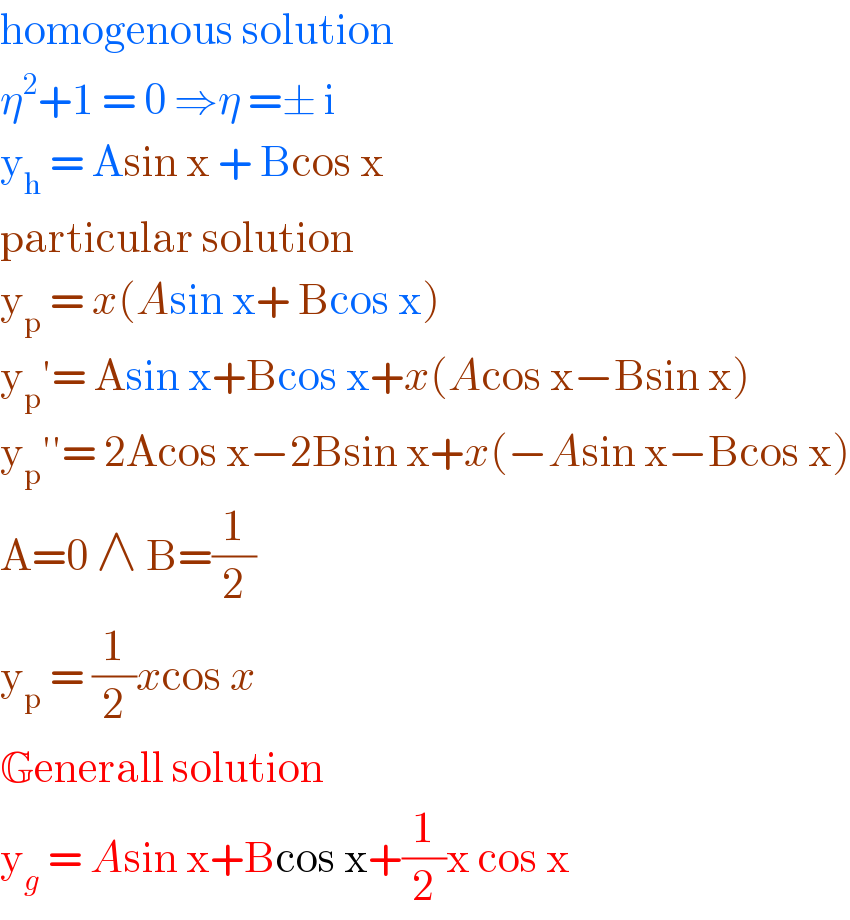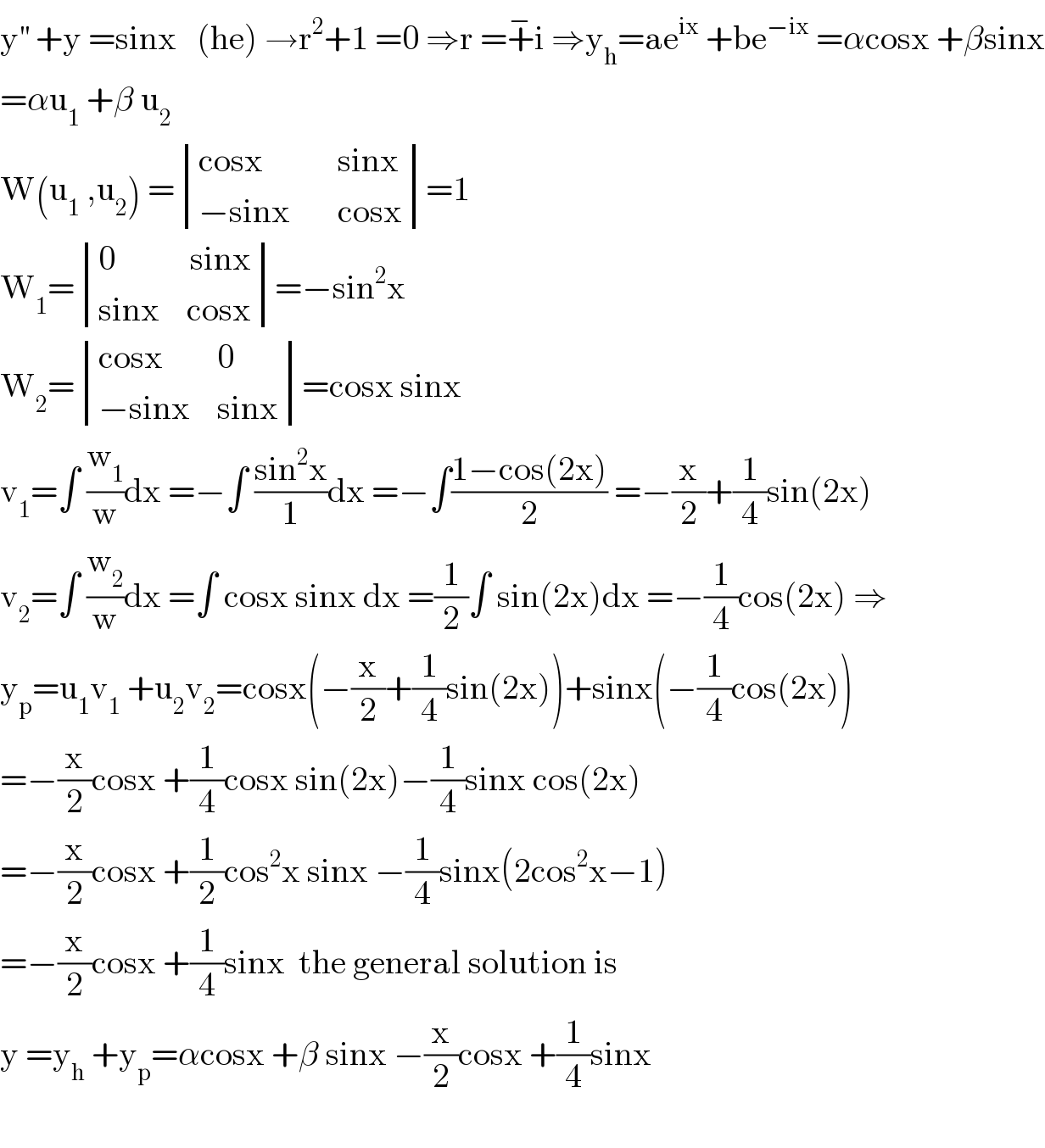Question Number 100344 by bemath last updated on 26/Jun/20

$$\mathrm{solve}\:\mathrm{y}''+\mathrm{y}\:=\:\mathrm{sin}\:\mathrm{x} \\ $$
Answered by bobhans last updated on 26/Jun/20

$$\mathrm{homogenous}\:\mathrm{solution} \\ $$$$\eta^{\mathrm{2}} +\mathrm{1}\:=\:\mathrm{0}\:\Rightarrow\eta\:=\pm\:\mathrm{i}\: \\ $$$$\mathrm{y}_{\mathrm{h}} \:=\:\mathrm{Asin}\:\mathrm{x}\:+\:\mathrm{Bcos}\:\mathrm{x} \\ $$$$\mathrm{particular}\:\mathrm{solution}\: \\ $$$$\mathrm{y}_{\mathrm{p}} \:=\:{x}\left({A}\mathrm{sin}\:\mathrm{x}+\:\mathrm{Bcos}\:\mathrm{x}\right)\: \\ $$$$\mathrm{y}_{\mathrm{p}} '=\:\mathrm{Asin}\:\mathrm{x}+\mathrm{Bcos}\:\mathrm{x}+{x}\left({A}\mathrm{cos}\:\mathrm{x}−\mathrm{Bsin}\:\mathrm{x}\right) \\ $$$$\mathrm{y}_{\mathrm{p}} ''=\:\mathrm{2Acos}\:\mathrm{x}−\mathrm{2Bsin}\:\mathrm{x}+{x}\left(−{A}\mathrm{sin}\:\mathrm{x}−\mathrm{Bcos}\:\mathrm{x}\right) \\ $$$$\mathrm{A}=\mathrm{0}\:\wedge\:\mathrm{B}=\frac{\mathrm{1}}{\mathrm{2}} \\ $$$$\mathrm{y}_{\mathrm{p}} \:=\:\frac{\mathrm{1}}{\mathrm{2}}{x}\mathrm{cos}\:{x}\: \\ $$$$\mathbb{G}\mathrm{enerall}\:\mathrm{solution}\: \\ $$$$\mathrm{y}_{{g}} \:=\:{A}\mathrm{sin}\:\mathrm{x}+\mathrm{Bcos}\:\mathrm{x}+\frac{\mathrm{1}}{\mathrm{2}}\mathrm{x}\:\mathrm{cos}\:\mathrm{x}\: \\ $$
Answered by mathmax by abdo last updated on 26/Jun/20

$$\mathrm{y}^{''} \:+\mathrm{y}\:=\mathrm{sinx}\:\:\:\left(\mathrm{he}\right)\:\rightarrow\mathrm{r}^{\mathrm{2}} +\mathrm{1}\:=\mathrm{0}\:\Rightarrow\mathrm{r}\:=\overset{−} {+}\mathrm{i}\:\Rightarrow\mathrm{y}_{\mathrm{h}} =\mathrm{ae}^{\mathrm{ix}} \:+\mathrm{be}^{−\mathrm{ix}} \:=\alpha\mathrm{cosx}\:+\beta\mathrm{sinx} \\ $$$$=\alpha\mathrm{u}_{\mathrm{1}} \:+\beta\:\mathrm{u}_{\mathrm{2}} \\ $$$$\mathrm{W}\left(\mathrm{u}_{\mathrm{1}} \:,\mathrm{u}_{\mathrm{2}} \right)\:=\begin{vmatrix}{\mathrm{cosx}\:\:\:\:\:\:\:\:\:\:\:\mathrm{sinx}}\\{−\mathrm{sinx}\:\:\:\:\:\:\:\mathrm{cosx}}\end{vmatrix}=\mathrm{1} \\ $$$$\mathrm{W}_{\mathrm{1}} =\begin{vmatrix}{\mathrm{0}\:\:\:\:\:\:\:\:\:\:\:\mathrm{sinx}}\\{\mathrm{sinx}\:\:\:\:\mathrm{cosx}}\end{vmatrix}=−\mathrm{sin}^{\mathrm{2}} \mathrm{x} \\ $$$$\mathrm{W}_{\mathrm{2}} =\begin{vmatrix}{\mathrm{cosx}\:\:\:\:\:\:\:\:\mathrm{0}}\\{−\mathrm{sinx}\:\:\:\:\mathrm{sinx}}\end{vmatrix}=\mathrm{cosx}\:\mathrm{sinx} \\ $$$$\mathrm{v}_{\mathrm{1}} =\int\:\frac{\mathrm{w}_{\mathrm{1}} }{\mathrm{w}}\mathrm{dx}\:=−\int\:\frac{\mathrm{sin}^{\mathrm{2}} \mathrm{x}}{\mathrm{1}}\mathrm{dx}\:=−\int\frac{\mathrm{1}−\mathrm{cos}\left(\mathrm{2x}\right)}{\mathrm{2}}\:=−\frac{\mathrm{x}}{\mathrm{2}}+\frac{\mathrm{1}}{\mathrm{4}}\mathrm{sin}\left(\mathrm{2x}\right) \\ $$$$\mathrm{v}_{\mathrm{2}} =\int\:\frac{\mathrm{w}_{\mathrm{2}} }{\mathrm{w}}\mathrm{dx}\:=\int\:\mathrm{cosx}\:\mathrm{sinx}\:\mathrm{dx}\:=\frac{\mathrm{1}}{\mathrm{2}}\int\:\mathrm{sin}\left(\mathrm{2x}\right)\mathrm{dx}\:=−\frac{\mathrm{1}}{\mathrm{4}}\mathrm{cos}\left(\mathrm{2x}\right)\:\Rightarrow \\ $$$$\mathrm{y}_{\mathrm{p}} =\mathrm{u}_{\mathrm{1}} \mathrm{v}_{\mathrm{1}} \:+\mathrm{u}_{\mathrm{2}} \mathrm{v}_{\mathrm{2}} =\mathrm{cosx}\left(−\frac{\mathrm{x}}{\mathrm{2}}+\frac{\mathrm{1}}{\mathrm{4}}\mathrm{sin}\left(\mathrm{2x}\right)\right)+\mathrm{sinx}\left(−\frac{\mathrm{1}}{\mathrm{4}}\mathrm{cos}\left(\mathrm{2x}\right)\right) \\ $$$$=−\frac{\mathrm{x}}{\mathrm{2}}\mathrm{cosx}\:+\frac{\mathrm{1}}{\mathrm{4}}\mathrm{cosx}\:\mathrm{sin}\left(\mathrm{2x}\right)−\frac{\mathrm{1}}{\mathrm{4}}\mathrm{sinx}\:\mathrm{cos}\left(\mathrm{2x}\right) \\ $$$$=−\frac{\mathrm{x}}{\mathrm{2}}\mathrm{cosx}\:+\frac{\mathrm{1}}{\mathrm{2}}\mathrm{cos}^{\mathrm{2}} \mathrm{x}\:\mathrm{sinx}\:−\frac{\mathrm{1}}{\mathrm{4}}\mathrm{sinx}\left(\mathrm{2cos}^{\mathrm{2}} \mathrm{x}−\mathrm{1}\right) \\ $$$$=−\frac{\mathrm{x}}{\mathrm{2}}\mathrm{cosx}\:+\frac{\mathrm{1}}{\mathrm{4}}\mathrm{sinx}\:\:\mathrm{the}\:\mathrm{general}\:\mathrm{solution}\:\mathrm{is} \\ $$$$\mathrm{y}\:=\mathrm{y}_{\mathrm{h}} \:+\mathrm{y}_{\mathrm{p}} =\alpha\mathrm{cosx}\:+\beta\:\mathrm{sinx}\:−\frac{\mathrm{x}}{\mathrm{2}}\mathrm{cosx}\:+\frac{\mathrm{1}}{\mathrm{4}}\mathrm{sinx} \\ $$$$ \\ $$
